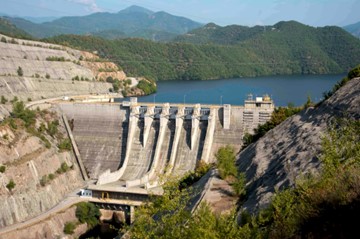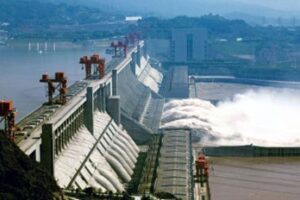Written by Margarita Kyrkou, surveyor & GIS specialist.
Hydropower, also known as hydroelectric power, is a form of renewable energy that harnesses the energy of flowing or falling water to generate electricity. It is one of the oldest and most widely used sources of renewable energy in the world. Also, it can play a crucial role in managing floods by providing a controlled release of water during heavy rain or snowmelt events.

Here’s how it can be used as a solution for floods:
- Flood Control Dams:
Many hydropower plants are equipped with dams that can be operated to store excess water during periods of heavy rainfall or snowmelt. By controlling the release of water, these dams can mitigate downstream flooding.
- Regulating Water Flow:
It’s facilities have the capability to quickly adjust the flow of water. During flood events, operators can reduce water release or temporarily store water to prevent downstream flooding.
- Reservoir Management:
Reservoirs associated with hydropower projects act as large storage systems. By controlling the levels of these reservoirs, operators can store excess water during high flow periods and release it gradually during drier times, reducing flood risks.
- Reducing Peak Flows:
Hydropower plants can attenuate peak flows during heavy rainfall or rapid snowmelt events. By capturing some of the excess water and releasing it in a controlled manner, they can help prevent sudden surges that lead to flooding.
- Integrated Flood Forecasting and Warning Systems:
Hydropower projects can be integrated into sophisticated flood forecasting systems. These systems use weather forecasts, river flow data, and other information to predict potential flood events. If a flood is anticipated, the hydropower system can be adjusted to mitigate its impact.
- Multi-Purpose Reservoirs:
Reservoirs designed for hydropower generation can also serve as flood control structures. By balancing the needs of power generation and flood control, these multi-purpose reservoirs can optimize water resource management.
- Environmental Benefits:
Well-designed hydropower projects consider environmental impacts. They can include features like fish-friendly turbines, fish ladders, and other measures to protect aquatic life, both during normal operations and flood events.
- Adaptive Management:
Climate change and other factors may alter precipitation patterns and flood risks. Hydropower projects should be designed with adaptability in mind, allowing for operational adjustments as conditions change.
- Community Engagement and Communication:
Collaboration with local communities and stakeholders is vital in planning and operating hydropower projects for flood control. Open communication channels and cooperation can lead to more effective flood management.
- Comprehensive Watershed Management:
Hydropower projects are most effective when integrated into a broader watershed management plan. This includes considering upstream and downstream impacts, land use planning, and other factors that can influence flood risks.
It’s important to note that while hydropower can be an effective tool for flood control, it is not a standalone solution. It should be integrated into a broader flood management strategy that includes other measures like levees, floodplain zoning, and early warning systems.
The world’s largest hydropower dam

Finally, it is interesting to mention the case of the world’s largest hydropower dam in West China. Three Gorges Dam was designed not only to generate electricity, but also to tame China’s longest river, shield millions of people from fatal floods and, as a symbol of technological prowess.
What are the advantages of the Three Gorges Dam? So far, the project has begun to bring benefits to Chinese people in mainly five aspects: flood control, power generation, navigation, drought resisting and tourism.
Find more ineresting articles by Wattcrop team!

